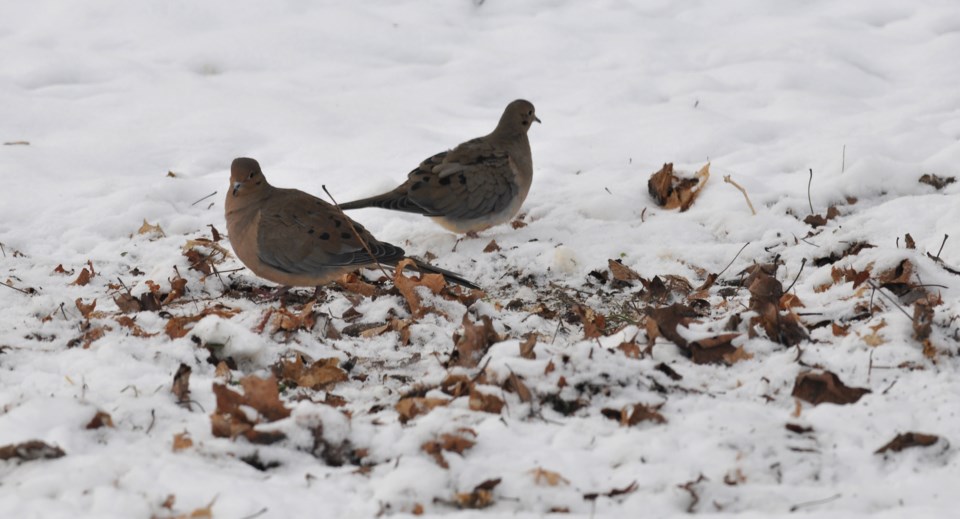As I shoveled the snow off the deck once again, moaning and groaning sounds seemed to echo throughout our valley. But this time it wasn’t coming from me (I’ve learned to moan and groan silently elsewise someone near and dear to me will suggest I go see the family doctor).
No, this time the sounds were coming from the nearby grove of pine trees, and hearing this call actually made me happy.
Just as the spring calls of crows, chickadees, nuthatches and cardinals foretell of warmer weather fast approaching, so too does the incessant sobbing call of the mourning dove.
They are well named, as their pigeon-like cooing sounds an awful lot like a person mourning someone near and dear recently deceased (probably didn’t go see the family doctor as suggested). So instead of being labeled as a ‘good morning’ dove, they have been saddled with that very dark Victorian tone of a moniker.
This species is one that has an interesting history in regards to its presence in Simcoe County. As mentioned in O. E. Devitt’s 1967 book, The Birds of Simcoe County, mourning doves were considered at that time a migratory bird that rarely overwintered here, with noteworthy observations from the winter of 1939-40 of three birds in a cornfield near Midhurst.
Nowadays it is unusual if there are only three birds in a cornfield.
The second edition of The Atlas of the Breeding Bird of Ontario (2001 -2005) has data to show that you have a 94 percent chance of seeing a mourning dove should you go looking for one. This clearly shows that these doves have increased their presence both seasonally and population wise.
So what’s up with that?
Research from those who study such things shows that mourning doves have taken advantage of a few factors: milder winters, increased corn production, and the proliferation of winter bird feeders.
Since the early 1960s, when these factors began to come into play, the doves have been increasing their population by about 10% every decade.
During the beginning of this surge in population there were several miscalls on identification, as the legends of the somewhat recent extinction passenger pigeons (1912) were still warm memories to some.
In 1915 a report of nesting passenger pigeons came from southern Quebec, and it took years to correct the story to the birds actually being the almost as rare mourning dove.
I myself got caught in that very scenario in 1969. My teenaged buddies and I were hunting pigeons in the Harvey and Horne cornfields just outside Orillia, fields that nowadays house Lakehead University and other urban sprawl.
A flock of pigeons flew by and within that group were two slim birds with long tails. Wait! What? Passenger pigeons? Being a neophyte birdwatcher at the time I called out for a “hold your fire” and excitedly explained to Mike and Randy that we have just witnessed a miraculous discovery!
Their raised eyebrows matched the expressions of others when I related this amazing tale. The Peterson field guide called them mourning doves. What the heck is a mourning dove?
As mentioned, today, mourning doves live with us year-round, and nesting often begins in March. Nests are flimsy twig structures, often quite conspicuous to even a casual observer. The first nesting is early spring and a second brood comes along in mid-summer; this double brood contributes to the steady rise in their population.
Males are slightly larger and a tad more colourful, so it is possible to determine the sex of the bird from an observation… try doing that with a blue jay or chickadee. During the incubation of the eggs the males sit on the nest during the daylight hours, and the females take their turn at night. Shared parenting, what a concept.
Baby doves are fed a slurry called ‘pigeon’s milk’ which is a regurgitation of ground up seeds from the crop of the adult. This is a trait shared by their cousin the rock dove (a.k.a. common pigeon).
Having raised pigeons in my youth (when not out hunting) this feeding of the young is a procedure well familiar to pigeon fanciers.
Mourning doves now occupy all of southern Ontario year round, and their range is continuing to creep northwards. Once confined to open countryside they are adapting to a changing climate and subsequent changing crops.
A few have been recorded in the Hudson Bay lowlands, not breeding but perhaps as scouts preparing for an exploration of a brave new world, dove-wise.
